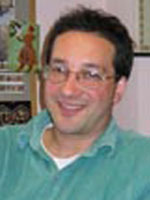Professor Andrew Jotischky
Contact Details
Department of History
University of Lancaster
Bailrigg, Lancaster
LA1 4YG
UK
Background
When and where did you initially develop an interest in the history of the crusades and/or the Latin East?
At school, during the A-level course in Medieval and Early Modern History.
Who or what sparked your enthusiasm for the subject?
Two prominent historians, Jonathan Riley-Smith and John Gillingham, participated in an A-level day conference at school, and they made a deep impression on me.
Education
Please provide details of your Higher Education, including dates, institution(s) and the name(s) of your research supervisors.
- 1988 - 91 PhD in History, Yale University. Research supervisor: John Boswell
- 1986 - 8 MPhil in Medieval Studies, Yale University
- 1983 - 9 BA (Hons) in History, Corpus Christi College Cambridge
Career History
Please provide details of your academic career history, including confirmation of your current institutional affiliation and contact details.
| 1995 | Lancaster University |
| 1995-2001: | Lecturer in History |
| 2001-2006: | Senior Lecturer in History |
| 2006-Present: | Professor of Medieval History |
| 1994-5: | (Stipendiary) Lecturer, St John’s and Brasnose Colleges, Oxford |
| 1992-4: | Temporary Lecturer in History, University of Manchester |
Influences and Methodologies
What ideas and/or methodologies have informed your approach to your research?
I have tried to derive my research questions from the surviving evidence and to stay as close as possible to the sources, but at the same time to integrate non-textual sources into my understanding of the past.
Research Outlook
What do you consider to be the most important avenues for future research in the field of crusader studies?
- The fuller integration of visual material into the study of Crusader society (eg icon painting, manuscript and wall painting, archaeology)
- Greater mastery of original languages, especially Arabic but also Coptic, Syriac and Armenian, in order to promote greater awareness of sources as yet unknown by most western historians.
Research Output
Please provide details of your research output, including publications and other media as appropriate.
Books (single-authored)
- Crusading and the Crusader States. Harlow: Longman Pearson, 2004.
- The Carmelites and Antiquity. Mendicant Views of the Past in the Middle Ages. Oxford: OUP, 2002.
- The Perfection of Solitude. Hermits and Monks in the Crusader States. University Park, PA: Penn State Press, 1995.
Books (Joint Authorship)
- The Penguin Historical Atlas of the Medieval World (co-author with Caroline Hull) Harmondsworth: Penguin, 2005.
Articles, Book Chapters, etc.
- ‘Mendicants as Missionaries and Travellers in the Near East in the Thirteenth and Fourteenth Centuries’ in Rosamund Allen (ed) Eastward Bound: Travel and Travellers in the East in the Middle Ages (Manchester, 2004), 88-106
- ‘Penance and Reconciliation in the Crusader States: Jacques de Vitry, Matthew Paris and the Eastern Christians’, in Kate Cooper and Jeremy Gregory (eds) Retribution, Repentance and Reconciliation. Studies in Church History 40 (2004), 74-83
- ‘Ethnographic Attitudes in the Crusader States: the Franks and the Indigenous Orthodox People’, in Krijnie Ciggaar and Herman Teule (eds) East and West in the Crusader States. Context, Contacts, Confrontations, III, Orientalia Lovaniensia Analecta 125 (Leuven, 2003), 1-19
- History and Memory as Factors in Greek Orthodox Pilgrimage to the Holy Land,’ in RN Swanson ed The Holy Land, Holy Lands and Christian History. Studies in Church History 36 (Woodbridge, 2000), 110-22
- ‘The Fate of the Greek Orthodox Church in Jerusalem at the End of the Twelfth Century,’ in T Hummel, U Carmesund and G Hintlian edsPatterns of the Past, Prospects for the Future: the Christian Heritage of the Holy Land (London, 1999), 179-94
- ‘Some mendicant views of the origins of the monastic profession,’ Cristianesimo nella Storia 19 (1998), 31-49
- ‘Gerard of Nazareth, Mary Magdalene and Latin relations with the Greek Orthodox in the Crusader East in the Twelfth Century,’ Levant 29 (1997), 217-26
- ‘Gerard of Csanad and the Carmelites: apocryphal sidelights on the First Crusade,’ in M Balard ed Autour de la première croisade. Actes du colloque de la Society for the Study of the Crusades and the Latin East (Clermont-Ferrand, 22-25 juin 1995) Byzantina Sorbonensia 14 (Paris, 1996), 143-55
- ‘The Carmelite Order and Greek Orthodox Monasticism: a study in retrospective unity,’ in RN Swanson ed Unity and Diversity in the Church. Studies in Church History 32 (Oxford, 1996) 117-29
- Gerard of Nazareth, John Bale and the origins of the Carmelite Order,’ Journal of Ecclesiastical History 46 (1995), 214-36
- ‘Manuel Comnenus and the Reunion of the Churches: the evidence of the conciliar mosaics in the Church of the Nativity in Bethlehem,’ Levant26 (1994), 207-25
Encyclopaedia Contributions
- Encyclopedia of the Crusades, ed Alan V Murray (ABC Clio, 2006). Entries on Black Mountain, Carmelite Order, Gerard of Nazareth, Albert of Vercelli.
- Oxford Dictionary of National Biography (Oxford: OUP, 2004) entries for Simon Stock, William of Coventry, Simon Tunsted, William Herbert, Robert Leicester.
- Encyclopaedia of Monasticism. Vol 1 A-L, ed William Johnston (Chicago: Chicago University Press, 2000): ‘Israel – Sites’
- The Penguin Atlas of British and Irish History ed Barry Cunliffe, Robert Bartlett, John Morrill, Asa Briggs and Joanna Bourke (London, 2001): ‘The Medieval Church’, ‘Britain and the Crusades’, ‘Castles’
Other Media
- ‘Geography and Travel in the Middle Ages’, Medieval Travel Writing. Adam Matthew On-line History Resources http://www.amdigital.co.uk/collections/Medieval-Travel-Writing/Default.aspx (2007)
Forthcoming Article
- ‘The Christians of Jerusalem, the Holy Sepulchre and the Origins of the First Crusade’, Crusades 7 (2008)

